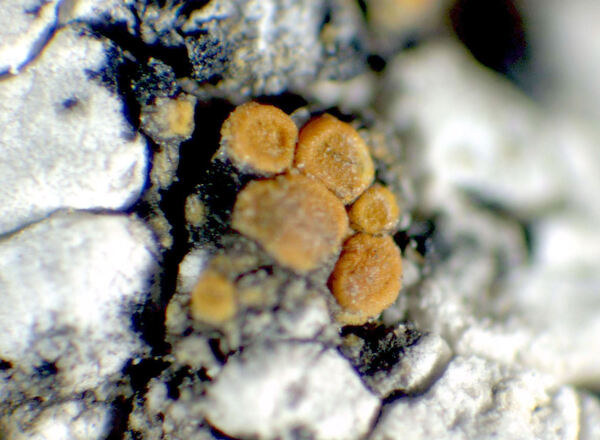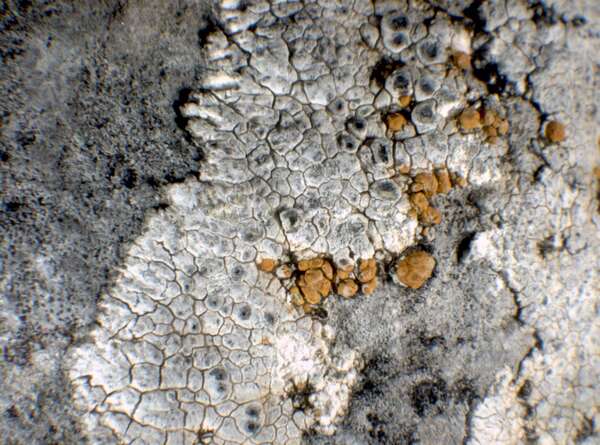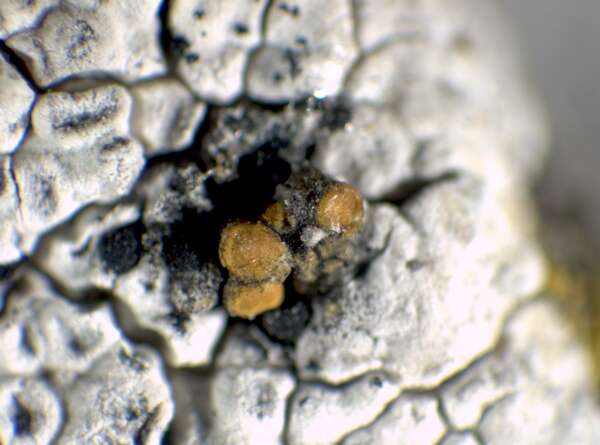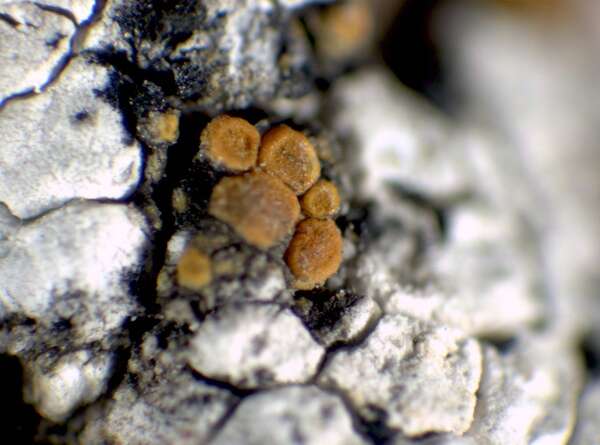Pachypeltis insularis (Poelt) Vondrák & I.V.Frolov
in Vondrák & al., Phytotaxa, 396, 1: 27, 2019.. Basionym: Caloplaca insularis Poelt - Planta, 51: 300, 1958.
Synonyms:
Description: Thallus orange- to ochraceous yellow, of 0.2-0.6 mm wide, subsquamulose areoles, or reduced to small granules-areoles around the apothecia, forming 2-4 mm wide spots on the thalli of Aspicilia species. Upper cortex weakly paraplectenchymatous; medulla white, loosely paraplectenchymatous, I+ blue (reaction best visible at the base of old apothecia). Apothecia zeorine, usually in small groups and deformed by mutual compression, (0.2-)0.4-0.6(-0.8) mm across, with an orange-brown, flat to slightly convex, rough disc, and a thick, paler, smooth proper margin; a reduced thalline margin is sometimes visible in young apothecia. Epithecium brownish orange, K+ purple-red; hymenium colourless, 80-90 μm high; paraphyses simple or sparingly branched, the apical cells up to 5 μm wide; hypothecium colourless, of strongly conglutinated hyphae, I+ blue in lowermost part. Asci 8-spored, clavate, functionally unitunicate, apically thickened with a broad internal beak, the inner part of apex and external cap I+ blue, Teloschistes-type. Ascospores 2-celled, polarilocular, hyaline, broadly ellipsoid to ellipsoid, (9-)10-13(-15) x 6-8(-9) μm, the equatorial thickening (“septum”) (1.5-)2-4 μm. Photobiont chlorococcoid. Spot tests: thallus and apothecia K+ purple-red, C-, KC-, P-. Chemistry: thallus and apothecia with parietin (major), fallacinal, emodin, teloschistin and parietinic acid (minor), corresponding with chemosyndrome A of Søchting (1997).
Growth form: Crustose
Substrata: rocks
Photobiont: green algae other than Trentepohlia
Reproductive strategy: mainly sexual
paras Aspicilia candida and A. polychroma
Commonnes-rarity: (info)
Alpine belt: rare
Subalpine belt: very rare
Montane belt: absent
Dry submediterranean belt: absent
Humid submediterranean belt: absent
Padanian area: absent
pH of the substrata:
1 2 3 4 5
Solar irradiation:
1 2 3 4 5
Aridity:
1 2 3 4 5
Eutrophication:
1 2 3 4 5
Poleotolerance:
0 1 2 3
Altitudinal distribution:
1 2 3 4 5 6
Rarity
absent
extremely rare
very rare
rare
rather rare
rather common
common
very common
extremely common
Loading data...
Occurrence data
Predictive map
Growth form: Crustose
Substrata: rocks
Photobiont: green algae other than Trentepohlia
Reproductive strategy: mainly sexual
paras Aspicilia candida and A. polychroma
Commonnes-rarity: (info)
Alpine belt: rare
Subalpine belt: very rare
Montane belt: absent
Dry submediterranean belt: absent
Humid submediterranean belt: absent
Padanian area: absent
pH of the substrata:
| 1 | 2 | 3 | 4 | 5 |
Solar irradiation:
| 1 | 2 | 3 | 4 | 5 |
Aridity:
| 1 | 2 | 3 | 4 | 5 |
Eutrophication:
| 1 | 2 | 3 | 4 | 5 |
Poleotolerance:
| 0 | 1 | 2 | 3 |
Altitudinal distribution:
| 1 | 2 | 3 | 4 | 5 | 6 |
Rarity
absent
extremely rare
very rare
rare
rather rare
rather common
common
very common
extremely common
Loading data...
Occurrence data
Predictive map










